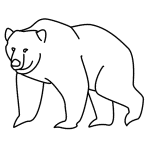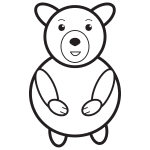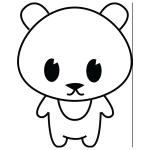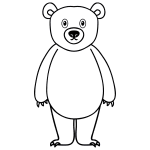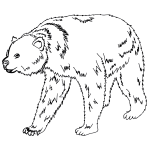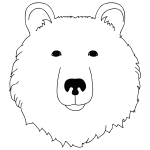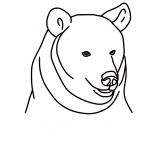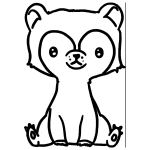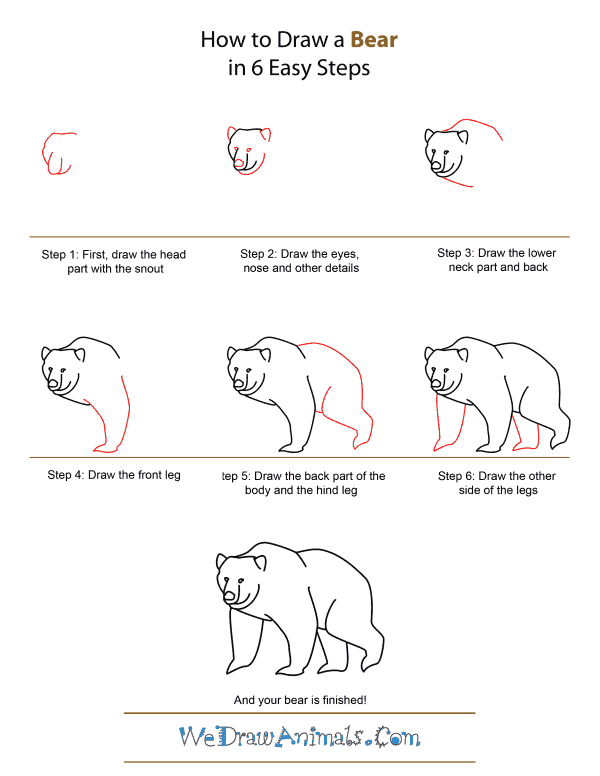In this quick tutorial you'll learn how to draw a Bear in 6 easy steps - great for kids and novice artists.
The images above represent how your finished drawing is going to look and the steps involved.
Below are the individual steps - you can click on each one for a High Resolution printable PDF version.
At the bottom you can read some interesting facts about the Bear.
Make sure you also check out any of the hundreds of drawing tutorials grouped by category.
How to Draw a Bear - Step-by-Step Tutorial
Step 1: First draw the head and snout. The head is like a large 'C' with a bumpy top. The snout touches the bottom of the head.
Step 2: Add the eyes, nose, ears and jaw. The small eyes are at the top of the snout. The ears are small and pointed on each side of the head.
Step 3: Now draw the back and neck part. There is a large bump in the back right behind the ear.
Step 4: Draw the front leg. It will start where you ended the neck. Make the top of the leg very wide, almost up to the back.
Step 5: Next we add the back part of the body and the hind leg. The hind leg is bent. The back of the hind leg joins up with the back of the body.
Step 6: Add another front leg and another back leg. The front leg should be under the head. The back leg will be straight.
Interesting Facts about Bears
Bears are part of the Ursidae family and are considered to be caniforms, or dog-like meat eaters. Their closest relatives are seals, raccoons, skunks, weasels and panda bears. When you look at or think of these animals you can definitely see the resemblance!
The first known bears appeared in North America about 38 million years ago. These bears were very small, graceful, “raccoon-like” creatures. The bears seen today are the most massive of all meat-eater animals, with some bears weighing over 1700 pounds!
During prehistoric times, bears were worshiped among hunting and fishing tribes, and in several cultures the bear was considered a symbol of ancestral spirits.
In the modern world, bears are very popular and have been featured in children’s books, television shows, commercials and films. Bears have also been represented as popular mascots, such as “Smokey the Bear,” mascot for the U.S. Forest Service and sports teams have adopted their name, like the Chicago Bears football team. Millions of cuddly “teddy bears” have been sold and cherished across the world, by both children and adults alike.
In the English language, characteristics of the bear have been used as figures of speech, such “bear hug,” meaning a tight, full-embrace, or “like a bear,” meaning stubborn.
Did you know?
- Bears are known for cleverly doubling back on anything tracking them and will even make false tracks to trick their tracker.
- Bears can roar, bark, moan, huff and growl.
- The common bear eats both meat and plants, the Polar bear eats only meat and the Panda bear mainly eats bamboo plants.
- Other than humans, the tiger is the only known predator of adult bears.
- Baby bears, or cubs, will stay with their mother for about three years, after which time the mother will run them off so they can fend for themselves.
- Four species of bear are especially dangerous to humans; the polar bear, the American black bear, the sloth bear and the brown bear.
- Bears have an excellent sense of smell that is even better than that of a dog, and may be better than any other mammal.
Like many wild animals that have roamed this earth for hundreds of centuries, the natural habitat of bears has been reduced due to human expansion across the land. In many areas of the world laws are being passed to help protect bear habitats so they may continue to live happy and healthy lives.

